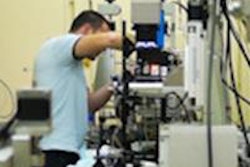
Exploiting the refraction of x-rays in tissue, x-ray phase-contrast imaging (XPCi) has the potential to significantly improve upon the image contrast provided by conventional absorption-based x-ray imaging and reduce doses. Clinical scanners are a long-term goal, but in the nearer future, 3D images could complement histology tests on biopsy samples. However, there have been few quantitative comparisons of XPCi techniques under development, motivating a European collaboration to examine three tomographic approaches.
"Different x-ray phase-contrast techniques have now been around for a few years, and it is important to compare their practical use in different scenarios," said author Timm Weitkamp, PhD, of the SOLEIL synchrotron near Paris. "Our study is one of the first of its kind."
Measuring phase changes
The experimental study compared the performance of x-ray grating interferometry (XGI), holotomography (HT), and single-distance phase retrieval (SDPR). The XGI technique uses an interference pattern, produced with a diffraction grating, as a reference. When a sample is placed in the beam, it distorts the line pattern. The lateral displacement of the pattern is used to derive variations in phase shift across the sample.
HT and SDPR are propagation-based techniques that also use interference to detect the x-ray phase variations that a sample creates. It does so by exploiting the Fresnel diffraction that occurs when x-rays propagate a distance -- ranging from tens of centimeters to a couple of meters -- from the sample to a detector. HT uses information from images recorded at several sample-to-detector distances.
 Top left: X-ray phase tomography slice of a rat's heart using propagation-based XPCi. Top right: X-ray phase tomography slice of a rat's heart using grating-based XPCi; the image has high contrast, but with some blurring compared to propagation-based XPCi. Bottom: conventional absorption-based x-ray CT with significantly lower contrast than phase-contrast scans.
Top left: X-ray phase tomography slice of a rat's heart using propagation-based XPCi. Top right: X-ray phase tomography slice of a rat's heart using grating-based XPCi; the image has high contrast, but with some blurring compared to propagation-based XPCi. Bottom: conventional absorption-based x-ray CT with significantly lower contrast than phase-contrast scans.For SDPR, the simplest of XPCi techniques, acquisition at a single distance and approximations of the sample and wavefront properties are used to estimate the sample's phase shift. The technique works well as long as the imaged object has only small variations in composition, as typically found in soft tissue.
Using a tumor excised from a mouse model and a healthy rat heart, the researchers implemented the three techniques using the ID19 beamline at the ESRF with monochromatic 17.6 keV and 19 keV x-ray beams, respectively. A CCD detector with effective pixel sizes of 3-8 mm was used. In each scan, the samples were rotated through 360° and approximately 1,500 projections were acquired (Journal of Applied Physics, 21 October, 2014, Vol. 116:15, pp. 154903)
Pros and cons
Analysis of the resulting scans revealed that each technique has advantages and limitations, qualitatively and quantitatively, as well as practically.
Examining image quality, significantly higher contrast-to-noise ratios (CNR) were observed for XGI scans, corresponding to more precise measurements of material density. For instance, in soft tissue in the heart, XGI gave a CNR of 55 compared with a range of 9-25 for the propagation-based techniques. For the same tissue, CNR values obtained from absorption scans constructed with the same data were less than one.
In a contrasting finding, HT and SDPR produced images with significantly better spatial resolution. Resolution for the two ranged from 8 mm to 12 mm, compared with 25 mm for XGI. The three techniques also varied in complexity. For example, data processing for SDPR, as well as acquisition, is the simplest of the three. Consequently, the researchers concluded that all three techniques are complementary tools that should be chosen according to the application.
"Scientists have to select the most appropriate technique for their visualization task," said co-author Bert Müller of the University of Basel in Switzerland, adding that the study will enable more informed choices and the advantages of each technique can be exploited if more than one approach is used to scan the same tissue sample.
© IOP Publishing Limited. Republished with permission from medicalphysicsweb, a community website covering fundamental research and emerging technologies in medical imaging and radiation therapy.



















